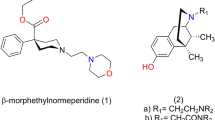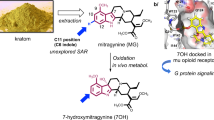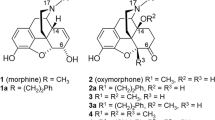Abstract
This study reports on new pharmacologically active endomorphin-2 analogues, incorporating β 2-hPhe, β 3-hPhe and β 3-hTic unnatural amino acids in the place of the Phe3–Phe4residues. Such α, β-hybrid analogues were designed to exploit the great potential of β-amino acids in generating conformational variation at the key positions 3 and 4, with the aim of evaluating the effect on the opioid binding affinity. Ligand-stimulated binding assays indicated that some analogues retained a significant affinity, especially for the δ receptor. 1H NMR and molecular modelling suggested the predominance of bent structures for all compounds. The molecular docking with the μ-opioid receptor model was also performed, highlighting a common binding mode for active compounds and helping to rationalize the observed structure–activity data.
Similar content being viewed by others
References
Seebach D, Gardiner J (2008) β-Peptidic peptidomimetics. Acc Chem Res 41: 1366–1375. doi:10.1021/ar700263g
Wu YD, Han W, Wang DP, Gao Y, Zhao YL (2008) Theoretical analysis of secondary structures of β-peptides. Acc Chem Res 41: 1418–1427. doi:10.1021/ar800070b
Cheng RP, Gellman SH, DeGrado WF (2001) β-Peptides: from structure to function. Chem Rev 101: 3219–3232. doi:10.1021/cr000045i
Horne WS, Gellman SH (2008) Foldamers with heterogeneous backbones. Acc Chem Res 41: 1399–1408. doi:10.1021/ar800009n
Vasudev PG, Chatterjee S, Shamala N, Balaram P (2011) Structural chemistry of peptides containing backbone expanded amino acid residues: conformational features of β, γ, and hybrid peptides. Chem Rev 111: 657–687. doi:10.1021/cr100100x
Sacchetti A, Silvani A, Lesma G, Pilati T (2011) Phe-Ala-based diazaspirocyclic lactam as nucleator of type II′ β-turn. J Org Chem 76: 833–839. doi:10.1021/jo1019927
Lesma G, Landoni N, Pilati T, Sacchetti A, Silvani A (2009) Tetrahydroisoquinoline-based spirocyclic lactam as a type II′ β-turn inducing peptide mimetic. J Org Chem 74: 8098–8105. doi:10.1021/jo901480d
Lesma G, Landoni N, Sacchetti A, Silvani A (2007) Pyrroloisoquinoline-based tetrapeptide analogues mimicking reverse-turn secondary structures. J Org Chem 72: 9765–9768. doi:10.1021/jo701581j
Lesma G, Landoni N, Sacchetti A, Silvani A (2010) The spiropiperidine-3,3′-oxindole scaffold: a type II β-turn peptide isostere. Tetrahedron 66: 4474–4478. doi:10.1016/j.tet.2010.04.077
Urman S, Gaus K, Yang Y, Strijowski U, Sewald N, De Pol S, Reiser O (2007) The constrained amino acid β-Acc confers potency and selectivity to integrin ligands. Angew Chem Int Edn 46: 3976–3978. doi:10.1002/anie.200605248
Tyndall JDA, Pfeiffer B, Abbenante G, Fairlie DP (2005) Over one hundred peptide-activated G protein-coupled receptors recognize ligands with turn structure. Chem Rev 105: 793–826. doi:10.1021/cr040689g
Blakeney JS, Reid RC, Le GT, Fairlie DP (2007) Nonpeptidic ligands for peptide-activated G protein-coupled receptors. Chem Rev 107: 2960–3041. doi:10.1021/cr050984g
Horvath G (2000) Endomorphin-1 and endomorphin-2: phar-macology of the selective endogenous μ-opioid receptor agonists. Pharmacol Therapeutics 88:437–463. doi:10.1016/S0163-7258(00)00100-5
Zadina JE, Hackler L, Ge LJ, Kastin AJ (1997) A potent and selective endogenous agonist for the μ-opiate receptor. Nature 386: 499–502. doi:10.1038/386499a0
Fichna J, Janecka A, Costentin J, Do Rego JC (2007) The endomorphin system and its evolving neurophysiological role. Pharmacol Rev 59: 88–123. doi:10.1124/pr.59.1.3
Janecka A, Staniszewska R, Fichna J (2007) Endomorphin Analogs. Curr Med Chem 14: 3201–3208
Leitgeb B (2007) Structural investigation of endomorphins by experimental and theoretical methods: hunting for the bioactive conformation. Chem Biodivers 4: 2703–2724. doi:10.1002/cbdv.200790221
Eguchi M (2004) Recent advances in selective opioid receptor agonists and antagonists. Med Res Rev 24: 182–212. doi:10.1002/med.10059
Gentilucci L, Tolomelli A (2004) Recent advances in the investigation of the bioactive conformation of peptides active at the micro-opioid receptor. conformational analysis of endomorphins. Curr Top Med Chem 4: 105–121
Gentilucci L, Tolomelli A, De Marco R, Spampinato S, Bedini A, Artali R (2011) The inverse type II β-turn on d-Trp-Phe, a pharmacophoric motif for MOR agonists. ChemMedChem 6: 1640–1653. doi:10.1002/cmdc.201100169
Torino D, Mollica A, Pinnen F, Feliciani F, Lucente G, Fabrizi G, Portalone G, Davis P, Lai J, Ma SW, Porreca F, Hruby VJ (2010) Synthesis and evaluation of new endomorphin-2 analogues containing (Z)-α,β-didehydrophenylalanine (ΔZPhe) Residues. J Med Chem 53: 4550–4554. doi:10.1021/jm1001343
Perlikowska R, Gach K, Fichna J, Tóth G, Walkowiak B, do-Rego JC, Janecka A (2009) Biological activity of endomorphin and [Dmt1]endomorphin analogs with six-membered proline surrogates in position 2. Bioorg Med Chem 17: 3789–3794. doi:10.1016/j.bmc.2009.04.046
Ballet S, Feytens D, De Wachter R, De Vlaemink M, Marczak ED, Salvadori S, de Graaf C, Rognan D, Negri L, Lattanzi R, Lazarus LH, Tourwé D, Balboni G (2009) Conformationally constrained opioid ligands: The Dmt-Aba and Dmt-Aia versus Dmt-Tic scaffold. Bioorg Med Chem Lett 19: 433–437. doi:10.1016/j.bmcl.2008.11.051
Balboni G, Fiorini S, Baldisserotto A, Trapella C, Sasaki Y, Ambo A, Marczak ED, Lazarus LH, Salvadori S (2008) Further studies on lead compounds containing the opioid pharmacophore Dmt-Tic. J Med Chem 51: 5109–5117. doi:10.1021/jm800587e
Tömböly C, Ballet S, Feytens D, Kövér KE, Borics A, Lovas S, Al-Khrasani M, Fürst Z, Tóth G, Benyhe S, Tourwé D (2008) Endomorphin-2 with a β-turn backbone constraint retains the potent μ-opioid receptor agonist properties. J Med Chem 51: 173–177. doi:10.1021/jm7010222
Ballet S, Salvadori S, Trapella C, Bryant SD, Jinsmaa Y, Lazarus LH, Negri L, Giannini E, Lattanzi R, Tourwé D, Balboni G (2006) New 2′,6′-Dimethyl-l-tyrosine (Dmt) opioid peptidomimetics based on the Aba-Gly Scaffold. Development of unique μ-opioid receptor ligands. J Med Chem 49: 3990–3993. doi:10.1021/jm0603264
Tömböly C, Kövér KE, Péter A, Tourwé D, Biyashev D, Benyhe S, Borsodi A, Al-khrasani M, Ronay AZ, Tóth G (2004) Structure–activity study on the phe side chain arrangement of endomorphins using conformationally constrained analogues. J Med Chem 47: 735–743. doi:10.1021/jm0310028
Shao X, Gao Y, Zhu C, Liu X, Yao J, Cui Y, Wang R (2007) Conformational analysis of endomorphin-2 analogs with phenylalanine mimics by NMR and molecular modeling. Bioorg Med Chem 15: 3539–3547. doi:10.1016/j.bmc.2007.02.050
Leitgeb B, Otvos F, Toth G (2003) Conformational analysis of endomorphin-2 by molecular dynamics methods. Biopolymers 68: 497–511
Leitgeb B, Szekeres A, Tóth G (2003) Conformational analysis of endomorphin-1 by molecular dynamics methods. Biopolymers. doi:10.1034/j.1
Yu Y, Shao X, Cui Y, Liu H, Wang C, Fan Y, Liu J, Dong S, Cui Y, Wang R (2007) Structure–activity study on the spatial arrangement of the third aromatic ring of endomorphins 1 and 2 using an atypical constrained C terminus. ChemMedChem 2: 309–317. doi:10.1002/cmdc.200600274
Borics A, Tóth G (2010) Structural comparison of μ-opioid receptor selective peptides confirmed four parameters of bioactivity. J Mol Graph Model 28: 495–505. doi:10.1016/j.jmgm.2009.11.006
Caputo R, Cassano E, Longobardo L, Palumbo G (1995) Synthesis of enantiopure N- and C-protected homo-β-amino acids by direct homologation of α-amino acids. Tetrahedron 51: 12337–12350. doi:10.1016/0040-4020(95)00778-7
Lee HS, Park JS, Kim BM, Gellman SH (2003) Efficient synthesis of enantiomerically pure β2-amino acids via chiral isoxazolidinones. J Org Chem 68: 1575–1578. doi:10.1021/jo026738b
Tessier A, Lahmar N, Pytkowicz J, Brigaud T (2008) Highly diastereoselective synthetic route to enantiopure β2-amino acids and γ-amino alcohols using a fluorinated oxazolidine (Fox) as chiral auxiliary. J Org Chem 73: 3970–3973. doi:10.1021/jo800562x
Albrizio S, Carotenuto A, Fattorusso C, Moroder L, Picone D, Temussi PA, D’Ursi A (2002) Environmental mimic of receptor interaction: conformational analysis of CCK-15 in solution. J Med Chem 45: 762–769. doi:10.1021/jm0109457
Shao X, Gao Y, Zhu C, Liu X, Yao J, Cui Y, Wang R (2007) Conformational analysis of endomorphin-2 analogs with phenylalanine mimics by NMR and molecular modeling. Bioorg Med Chem 15: 3539–3547. doi:10.1016/j.bmc.2007.02.050
Grathwohl C, Wüthrich K (1981) NMR studies of the rates of proline cis–trans isomerization in oligopeptides. Biopolymers 20: 2623–2633. doi:10.1002/bip.1981.360201209
Keresztes A, Szűcs M, Borics A, Kövér KE, Forró E, Fülöp F, Tömböly C, Péter A, Páhi A, Fábián G, Murányi M, Tóth G (2008) New endomorphin analogues containing alicyclic β-amino acids: influence on bioactive conformation and pharmacological profile. J Med Chem 51: 4270–4279. doi:10.1021/jm800223t
Mallareddy JR, Borics A, Keresztes A, Kövér KE, Tourwé D, Tóth G (2011) Design, synthesis, pharmacological evaluation, and structure–activity study of novel endomorphin analogues with multiple structural modifications. J Med Chem 54: 1462–1472. doi:10.1021/jm101515v
Wilczyńska D, Kosson P, Kwasiborska M, Ejchart A, Olma A (2009) Synthesis and receptor binding of opioid peptide analogues containing β 3-h-amino acids. J Pept Sci 15: 777– 782
Manglik A, Kruse AC, Kobilka TS, Thian FS, Mathiesen JM, Sunahara RK, Pardo L, Weis WI, Kobilka BK, Granier S (2012) Crystal structure of the μ-opioid receptor bound to a morphinan antagonist. Nature 485: 321–326. doi:10.1038/nature10954
Granier S, Manglik A, Kruse AC, Kobilka TS, Thian FS, Weis WI, Kobilka BK (2012) Structure of the δ-opioid receptor bound to naltrindole. Nature 485: 400–404. doi:10.1038/nature11111
Mosberg HI, Fowler CB (2002) Development and validation of opioid ligand–receptor interaction models: the structural basis of μ vs δ selectivity. J Pept Res 60: 329–335
Gentilucci L, Tolomelli A, De Marco R, Artali R (2012) Molecular docking of opiates and opioid peptides, a tool for the design of selective agonists and antagonists, and for the investigation of atypical ligand–receptor interactions. Curr Med Chem 19: 1587–1601. doi:10.2174/092986712799945030
Liu X, Kai M, Jin L, Wang R (2009) Molecular modeling studies to predict the possible binding modes of endomorphin analogs in μ opioid receptor. Bioorg Med Chem Lett. doi:10.1016/j.bmcl.2009.07.121
Liu X, Kai M, Jin L, Wang R (2009) Computational study of the heterodimerization between μ and δ receptors. J Computer-Aid Mol Des 23: 321–332. doi:10.1007/s10822-009-9262-7
Urban JD, Clarke WP, Von Zastrow M, Nichols DE, Kobilka B, Weinstein H, Javitch JA, Roth BL, Christopoulos A, Sexton PM, Miller KJ, Spedding M, Mailman RB (2007) Functional selectivity and classical concepts of quantitative pharmacology. J Pharmacol Exp Ther 320: 1–13. doi:10.1124/jpet.106.104463
Nevin ST, Kabasakal L, Otvös F, Tóth G, Borsodi A (1994) Binding characteristics of the novel highly selective delta agonist, [3H]Ile5,6deltorphin II. Neuropeptides 26: 261–265. doi:10.1016/0143-4179(94)90080-9
Tóth G, Ioja E, Tömböly C, Ballet S, Tourwé D, Péter A, Martinek T, Chung NN, Schiller PW, Benyhe S, Borsodi A (2006) β-Methyl substitution of cyclohexylalanine in dmt-tic-cha-phe peptides results in highly potent δ opioid antagonists. J Med Chem 50: 328–333. doi:10.1021/jm060721u
Spartan ’08, Wavefunction, Inc. Irvine, CA
Maestro, version 9.0 (2011) Schrödinger, LLC, New York
Glide, version 5.5 (2011) Schrödinger, LLC, New York
Park M, Gao C, Stern HA (2011) Estimating binding affinities by docking/scoring methods using variable protonation states. Proteins 79: 304–314
Friesner RA, Murphy RB, Repasky MP, Frye LL, Greenwood JR, Halgren TA, Sanschagrin PC, Mainz DT (2006) Extra precision glide: docking and scoring incorporating a model of hydrophobic enclosure for protein–ligand complexes. J Med Chem 49: 6177–6196. doi:10.1021/jm051256o
Friesner RA, Banks JL, Murphy RB, Halgren TA, Klicic JJ, Mainz DT, Repasky MP, Knoll EH, Shaw DE, Shelley M, Perry JK, Francis P, Shenkin PS (2004) Glide: a new approach for rapid, accurate docking and scoring. 1. Method and assessment of docking accuracy. J Med Chem 47: 1739–1749. doi:10.1021/jm0306430
Halgren TA, Murphy RB, Friesner RA, Beard HS, Frye LL, Pollard WT, Banks JL (2004) Glide: a new approach for rapid, accurate docking and scoring. 2. enrichment factors in database screening. J Med Chem 47: 1750–1759. doi:10.1021/jm030644s
Author information
Authors and Affiliations
Corresponding authors
Electronic Supplementary Material
The Below is the Electronic Supplementary Material.
Rights and permissions
About this article
Cite this article
Lesma, G., Salvadori, S., Airaghi, F. et al. Synthesis, pharmacological evaluation and conformational investigation of endomorphin-2 hybrid analogues. Mol Divers 17, 19–31 (2013). https://doi.org/10.1007/s11030-012-9399-5
Received:
Accepted:
Published:
Issue Date:
DOI: https://doi.org/10.1007/s11030-012-9399-5




